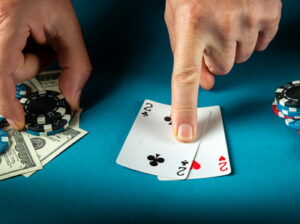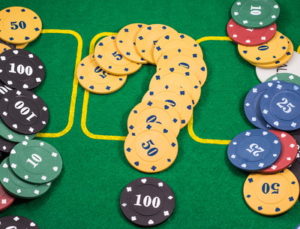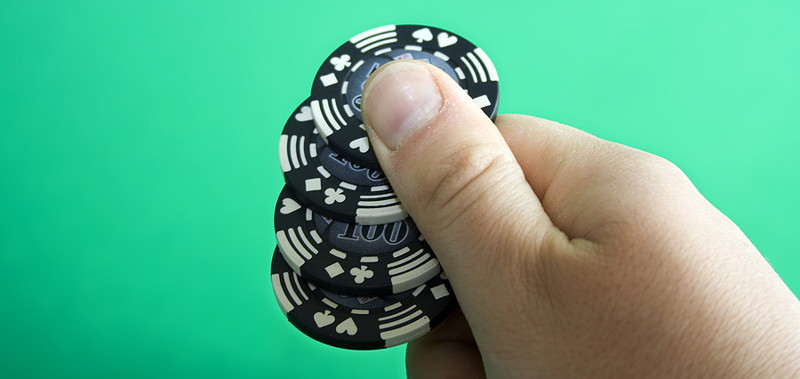 Knowing and mastering the math behind the gambling games is recognised as an important skill factor for some games. The most relevant example in this respect is poker, where the most constant winners are those able to estimate and weight the odds in every moment of the game. These mathematical skills along with other psychological skills, like reading opponents, are what make the difference between average and professional players.
Knowing and mastering the math behind the gambling games is recognised as an important skill factor for some games. The most relevant example in this respect is poker, where the most constant winners are those able to estimate and weight the odds in every moment of the game. These mathematical skills along with other psychological skills, like reading opponents, are what make the difference between average and professional players.
In Hold’em poker, odds are far more difficult to compute than in any other game, and I am talking of course about on-paper computation outside the game. Besides, there are tens of millions of possible card configurations, each having associated different odds for the various events you want to measure.
Of course, such math work is not at everybody’s hand and requires time to be completed, which we don’t have during a live game, where a decision should be taken in seconds.
In this article we will see what options are for specific computing techniques to be applied for odds estimation during the game of Hold’em poker, and what cognitive and math skills are required for a player to apply them.
Importance & challenge of estimating odds during Hold’em poker
 Poker is a game where odds estimations really count in any objective strategy, even more than in blackjack. That’s because the strength of your hand at any moment can only be evaluated in terms of probabilities and your action depends on this evaluation. In Hold’em poker, the odds estimation is crucial for taking an advantage over your opponents and those mastering the math of Hold’em get in the top of success.
Poker is a game where odds estimations really count in any objective strategy, even more than in blackjack. That’s because the strength of your hand at any moment can only be evaluated in terms of probabilities and your action depends on this evaluation. In Hold’em poker, the odds estimation is crucial for taking an advantage over your opponents and those mastering the math of Hold’em get in the top of success.
Estimating accurately the Hold’em odds in mind is also part of the math skills required for success. There are two main reasons for that: One is that probabilities for both your hand and for your opponents’ hands change dramatically with every new card dealt on the board, more than in other card games.
The other is that Hold’em poker allows both expectation-based optimal strategies and probability-based optimal strategies and both require accurate odds estimations. However, applying them during the game is the real challenge, as the math aspects of the game are not quite simple to follow and memorise.
First, there is no expert resource available that lists all the odds associated with this game, like it is for blackjack (in terms of totals). Poker is a combinatorial game whose probabilities are the most difficult to compute. The huge number of possibilities for the card configuration prevents a relevant simplification by breaking them down to few relevant distinct types.
There are 2,598,960 possible card combinations for your hole cards and the flop. There are 20,358,520 such combinations for your hole cards and the board in the turn stage. You will find resources providing explicit formulas for most of the probabilities involved, but these are not of much help for estimating odds during a game (some of these formulas stretch over one page, including those for long-shot odds; if using software for returning their numerical results, the multitude of the variables makes impossible the decent listing of the odds into tables easy for access and memorisation).
Types of odds in Hold’em poker and how to approach them
 In Hold’em we have the immediate odds, which are odds of events that occur with the next stage in the game’s progress (for example, the flop configuration in Hold’em after you receive your hole cards, or your turn card, or the odds that one of your opponents holds certain cards); we have long-shot odds, which are odds of two- or more-steps events (for example, draws with two or more cards to come for your hand or on the board, or the odds that your hand will beat your opponents’ hands, estimated before the river).
In Hold’em we have the immediate odds, which are odds of events that occur with the next stage in the game’s progress (for example, the flop configuration in Hold’em after you receive your hole cards, or your turn card, or the odds that one of your opponents holds certain cards); we have long-shot odds, which are odds of two- or more-steps events (for example, draws with two or more cards to come for your hand or on the board, or the odds that your hand will beat your opponents’ hands, estimated before the river).
We also have odds for your own hand and for your opponent’s hands. We have odds for one opponent and odds for any opponent or at least one opponent. There are direct or conditional probabilities. Overall, there are several types of odds and each type may break down in hundreds or thousands of general odds, depending on the moment or stage when the odds are estimated.
Some of these odds are easier to compute manually, others are more difficult and others are actually impossible. We are talking of course about computing them in silence, out of the time pressure. When we are in the middle of the action and recalling memorised results is not working, the only thing available is to try a quick estimation; however, this have to be objective and as accurate as possible, not by feeling – probability evaluation may be tricky think for those unaware and should be done only by mathematical means.
Any objective estimation should be based on the classical formula of probability: P(E) = n/m, where n is the number of situations favourable for event E to occur, and m is the total number of equally-possible situations. If the event E is defined by more cards to come, then n and m are certain numbers of combinations of cards (this is why P is also called in this case combinatorial probability).
Example:
If event A refers to the flop cards in a Hold’em game where you were dealt your hole cards, then m is C(50, 3), because there are 50 unknown cards and 3 is the number of cards on the flop. This number is 19,600.
With this basic formula, the real challenge is to estimate the n, as m can be known in advance, depending on the situation.
The rule of 4 and 2
 Those using the expectation-based strategy in poker use the pot odds criterion: Call or raise only if your pot odds are lower than the estimated probability of winning the hand. In poker strategy jargon, this latter probability is also called equity.
Those using the expectation-based strategy in poker use the pot odds criterion: Call or raise only if your pot odds are lower than the estimated probability of winning the hand. In poker strategy jargon, this latter probability is also called equity.
Estimating equity reverts of course to estimating card odds. Given that you may win the hand with more than one target draw, an accurate equity would assume estimating the odds for every possible target draw, then do the probability of their disjunction (one or another), then estimate the conditional probability of your opponents beating your hand if one of the target draws is hit.
It’s an extremely complicated computation, whatever the given configuration. In practice, players simplified things at the maximum possible, by just focusing on the most probable target draw, and ignoring the other draws and the opponents’ odds. But still in this simplified (and thus inaccurate) case, the odds estimation is not always simple and doing it in mind in a quick time is not for everyone.
Over time, the poker expert community proposed a rule of estimating the card odds, thought to be effective during the game. Called the rule of 4 and 2, it works like this:
- In the flop stage, count your outs (undealt cards favourable for completing your most probable target draw).
- Multiply the number of outs by 4 and apply the percentage to obtain the approximate probability of hitting your target draw on the turn or on the river.
- In the turn stage, multiply the current number of outs by 2 and apply the percentage to obtain the approximate probability of hitting your target draw on the river.
Example:
A flush draw with 9 outs in the flop stage will have, per the 4 and 2 rule, a probability of being hit by river of 9 x 4% = 36%. In the turn stage, assuming 9 outs remaining, the probability would be 9 x 2 % = 18%.
Let’s check the results above against the exact probabilities: The probability of hitting the flush by river computed in the flop stage is [9x(47 – 9) + C(9,2)]/C(47,2) = 34.96%. Computed in the turn stage, the probability becomes 9/46 = 19.56%. Very close, indeed. But don’t get too excited with this particular example. The truth is that the rule of 4 and 2 is not applicable in any situation!
Counterexample:
Assume your hole cards are (96) and the flop cards are (9A2). The most advantageous target draw is a full house of 9s, namely (99966). The probability for this full house to be hit by river is 0.555%. The rule of 4 and 2 would give for this draw 5 (outs) x 4 = 20, so 20% probability, 36 times as high as the exact number. Not that close, right?
Even taking the target draw to be ‘any full house of 9s’, which has a probability of 1.665%, the rule still gives an inaccurate result: 11 (outs) x 4 = 44.
Such counterexamples may be provided in the order of thousands and prove that the rule of 4 and 2 is inaccurate in most of the situations. Yet this rule is advertised as effective without limitations on many online poker resources claimed as expert.
The fact is that the rule works mostly in the turn stage and flop stage for the flush draw, the quads draw, and in some particular situations for the two-pair draw. In general, it does not work when the target draw is a disjunction of several possible draws (something or better). In such and all other cases not covered by the rule, no rule of thumb can substitute exact or approximate probability estimation.
How to approach in-mind odds estimation in Hold’em
![]()
Not every probability is effectively computable in Hold’em, if we refer to complex events (like those conditional, or involving one or more opponents beating your predicted hand).
Whatever the complexity of the measured event, no explicit general probability formula is feasible when talking about in-mind numerical estimation. That’s because a math formula is more difficult to be memorised and applied during the game than a computation algorithm and there are several variables involved, which should be first replaced by the parameters describing the given situation.
This is why a prerequisite for any endeavour of estimating Hold’em odds during the game is to apply and adjust your computations to particular situations (the specific cards in your hand and on the board) and not applying general formulas.
With this approach a skilled player may come to estimate odds for their own hand and even for one or more opponents. These can be immediate odds, but also large categories of long-shot odds.
Before talking about such techniques, it is important to know that such estimations cannot be done in a short time without memorising in advance some pre-calculated results – these are the values of the denominator m of the probability fraction in each category of situations, and some numbers of combinations, for the most frequent parameters (counting for the estimation of the numerator n).
Applying the classical formula of probability

Say you have established a target draw for your hand and you want the probability that you will hit it by a certain stage of the game.
If that stage assumes one card to come on the board, then n is just the number of outs missing in your draw, which you need to count before making the ration n/m.
Example:
If you are in the flop stage with your hole cards (KA) and the flop cards (KA3), and you want to estimated your odds for a full house with the turn card, than your outs are the unseen Ks and Aces, so n = 2 + 2 = 4. The denominator m is m = 52 – 2 – 3 = 47, all unseen cards. Then, the probability is P = n/m = 4/47 = 1/11.75.
If that stage assumes two cards to come, then n will be counted as number of combinations that are favourable for your draw.
Example:
Keep the same configuration as in the previous example and say you want your odds for a full house by river, estimated in that flop stage. Then, your favourable combinations are those holding one K (denote them (Kx)), one A (denote them (Ay)), or both (KA). We have to count them each:
(Kx): There are 2 kings left and the number of the x cards is the number of the cards left that are not kings: 52 (all the cards) – 5 (the seen cards, flop plus hole cards) – 2 (kings not seen) = 45. The number of combinations (Kx) is then 2 x 45 = 90.
(Ay): We have the same number of combinations (90), as there is the same number of aces as kings seen.
(KA): 2 (unseen kings) x 2 (unseen aces) = 4.
Then, n should be counted as the sum of all favourable combinations: n = 90 + 90 + 4 = 184.
The m number is the number of all possible combinations of two cards from all the unseen cards. This is C(47,2) = 1,081. Then, P = n/m = 184/1,081, which is about 1 in 6.
It may happen you for target draw to require the same card rank (or symbol) in the expected two-card combination. In this case, the number of these combinations is not computed as a product (as in the example above), but in combinatorial mode.
Example
For instance, if you need 2 queens from the turn and river cards (QQ), and say there are 3 queens as outs, then the number of the (QQ) combinations is C(3,2) = 3, which you have to divide to m to find the probability.
Or, if you need 2 cards of clubs (♣♣) and there are 9 cards of clubs as outs, the number of combinations is C(9,2) = 36.
Units of computation for two cards to come
 In general, there are three categories of fractions expressing combinatorial probabilities for 2-card favourable combinations:
In general, there are three categories of fractions expressing combinatorial probabilities for 2-card favourable combinations:
- For favourable combinations of the type (Cx), where C is a card of a given rank or symbol, the fraction is P = number of (Cx) / C(52 – N, 2), where N is the number of seen cards.
The numerator n = number of (Cx) combinations, is computed as a product: number of outs (C cards) x (52 – N – number of outs), as we did in the example above.
- For favourable combinations of the type (CD), where C and D are cards of different given values or symbols, the fraction is P = number of (CD) / C(52 – N, 2).
The n = number of (CD) combinations, is computed as a product: number of outs (C cards) x (number of outs (D cards)).
- For favourable combinations of the type (CC), where C are cards of a given value or symbol, the fraction is P = number of (CC) / C(52 – N, 2).
The n = number of (CC) combinations is computed in combinatorial mode: C(number of outs, 2).
These are the basic units of computation, however these can be combined within the same estimation, when the target event is expressed as a disjunction of several draws. In such a case, all favourable combinations for all the constituent target draws should be counted and we also should take care not to count some of them twice. Of course, such a case increases the difficulty of the estimation and selecting the dominant probability is a recommended choice, where available.
The units of computation for combinations of two unknown cards also apply when trying to estimate the odds for one opponent to hit or have hit a certain draw (because their hole cards are two).
Example:
Assume you are in the river stage, with your hole cards (JJ) and the board (457JQ). You want the odds for one of your opponents to hold (QQ) and as such beat your J-set.
The favourable combinations (for your opponent) are (QQ), in number of C(3,2) = 3 (there are three outs of Q). The probability is a fraction of type 3 in our list above: P = 3/C(52 – 7, 2) = 3/C(45,2) = 3/990 = 1/330.
If there are several opponents in play and you want the probability that at least one of them holds (QQ), you may multiply the sought probability with the number of opponents. You are allowed to do this simple multiplication because no two opponents can hold (QQ) simultaneously, as there are only 3 queens left.
All these were simple examples, however the more complex are the measured events the most difficult the odds estimation is and the most part of them cannot be done in mind, whatever experienced a player would be.
In theory there are various techniques of approximation for the odds computation in Hold’em (selecting the dominant probability, selecting types of card formations, reducing the formulas, and narrowing the approximation intervals), but all these are math work feasible on the paper and not when doing estimation in mind in a quick time.
Especially in poker, such skills are only possible for the gifted ones and also require very long-time practice. Given that such skills involve applicable math techniques of simplification and approximation and no expert resources are available for teaching them, they are acquirable and trainable only by attending specific highly specialised poker-math courses.
Combinatorial information to memorise in advance
![]() The minimal knowledge base necessary for giving such in-mind computations a chance during the game consists of memorised pre-calculated results, namely numbers of favourable combinations (used to estimate n) and number of possible combinations (m) for the various categories of events.
The minimal knowledge base necessary for giving such in-mind computations a chance during the game consists of memorised pre-calculated results, namely numbers of favourable combinations (used to estimate n) and number of possible combinations (m) for the various categories of events.
Here are the usual results needing memorisation:
Number of favourable combinations (C(a,b) means the number of combinations of a cards taken each b.)
| No. of combinations | Usage | No. of combinations | Usage |
|---|---|---|---|
| C(3,2) = 3 | outs of the same rank | C(9,2) = 36 | outs of the same suit |
| C(4,2) = 6 | outs of the same rank or of two ranks | C(9,3) = 84 | outs of the same suit |
| C(4,3) = 4 | outs of the same rank or of two ranks | C(10,2) = 45 | outs of the same suit |
| C(5,2) = 10 | outs of two ranks | C(10,3) = 120 | outs of the same suit |
| C(5,3) = 10 | outs of two ranks | C(11,2) = 55 | outs of the same suit |
| C(6,2) = 15 | outs of two ranks or of the same suit | C(11,3) = 165 | outs of the same suit |
| C(6,3) = 20 | outs of two ranks or of the same suit | C(12,2) = 66 | outs of the same suit |
| C(7,2) = 21 | outs of two ranks or of the same suit | C(12,3) = 220 | outs of the same suit |
| C(7,3) = 35 | outs of two ranks or of the same suit | C(13,2) = 78 | outs of the same suit |
| C(8,2) = 28 | outs of two ranks or of the same suit | C(13,3) = 286 | outs of the same suit |
| C(8,3) = 56 | outs of two ranks or of the same suit | C(13,4) = 715 | outs of the same suit |
Number of possible combinations (m)
| Event referring to | No. of possible combinations |
|---|---|
| Flop cards (given your hole cards) | C(50,3) = 19,600 |
| One opponent’s hole cards (given the flop cards and your hole cards) | C(47,2) = 1,081 |
| Turn card (given the flop cards and your hole cards) | 47 |
| River card (given the flop and turn cards and your hole cards) | 46 |
| Turn and river cards (given the flop cards and your hole cards) | C(47,2) = 1,081 |
| One opponent’s hole cards (given the flop and turn cards and your hole cards) | C(46,2) = 1,035 |
| One opponent’s hole cards (given the flop, turn, and river cards and your hole cards) | C(45,2) = 990 |
When estimating n is difficult or you don’t have the skills to do that in quick time, knowing only the number m in advance may be of a real help, as it gives some clue about how likely is for your target draw to be hit or for your opponents to hold certain cards.
Example:
In the river stage with heads up, the board is (JJ992) and your hole cards (9A). You want to estimate the chances for your opponent to hold a J to beat your full house of 9s. You know the number of possible combinations from the table above, namely 990, but don’t know how to count the favourable (for the opponent) combinations (Jx) and (JJ).
There are 2 outs in the 45 unseen cards, so you may fairly think that n is lower than 2 x 45 = 90. Taking (inaccurately) n = 90 and dividing it a 990, you find a maximal probability of 1/11, which is a low one. The accurate probability will be even lower (in fact, n is 87 and the probability is 87/990).
Conclusion
Odds computations in Hold’em poker are very complex and require specific mathematical techniques of approximation, at least for the complex events.
There are no public expert resources providing such techniques and teaching players how to apply them, so ambitious math-inclined players may acquire and train such skills in long practice, under the guidance of an expert.
In training such skills, learning the basic units of computation, along with memorising the combinatorial information for the usual situations, is the process to start with.
About The Author
The author of this page is Dr. Catalin Barboianu. Catalin is a mathematician specialising in gaming and responsible gambling and a research associate at the University of Bucharest.
